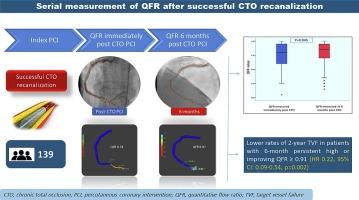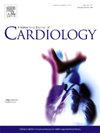Serial quantitative flow ratio measurements of a successfully recanalized coronary chronic total occlusion
IF 3.2
2区 医学
Q2 CARDIAC & CARDIOVASCULAR SYSTEMS
引用次数: 0
Abstract
Background
Physiological assessment is useful in detecting suboptimal results after percutaneous coronary intervention (PCI). However, after angiographically successful PCI of a chronic total occlusion (CTO), coronary perfusion changes over time, which may impact physiological assessment.
Purpose
To evaluate the functional results of CTO PCI measured by quantitative flow ratio (QFR) immediately and 6 months following the PCI.
Methods
We retrospectively included patients with a successful CTO-PCI from a single center between 2017 and 2020. A total of 139 patients who fulfilled the QFR eligibility criteria, out of 470 CTO-PCIs, were enrolled. The QFR was measured off-line in the target vessel immediately post-index procedure and after a follow-up of 6 months.
Results
The mean age was 67.3 ± 10 years, and 80.6% were males. 74.8% of lesions had J-CTO score ≥2, retrograde approach was used in 10.8%. The median QFR immediately after successful CTO-PCI was 0.96 IQR [0.92-0.99] which increased to 0.97 IQR [0.94-0.99] after follow-up (p=0.045). Immediately post CTO-PCI, 19.4% (n=27) of patients had QFR < 0.91, and 80.6% (n=112) had QFR ≥ 0.91. After 6 months, QFR increased significantly in patients with initial suboptimal QFR (0.87 IQR [0.85-0.88] vs 0.97 IQR [0.92-0.99], p<0.001). Patients with persistent high QFR or those with improving QFR ≥ 0.91 at follow up had lower rates of two-year target vessel failure (HR 0.22, 95% CI: 0.09-0.54, p=0.002).
Conclusion
After CTO recanalization, QFR increased significantly at 6 months in most of the patients with low initial values. Patients with persistent high QFR or those with improving QFR ≥ 0.91 after a short-term follow up had lower rates of two-year TVF.

成功再通冠状动脉慢性全闭塞的连续定量血流比测量。
背景:生理评估有助于发现经皮冠状动脉介入治疗(PCI)后的次优结果。然而,在慢性全闭塞(CTO)的冠脉造影成功后,冠状动脉灌注随时间变化,这可能影响生理评估。目的:评价CTO PCI术后即刻及术后6个月定量流量比(QFR)测量的功能结果。方法:我们回顾性地纳入了2017年至2020年间在单一中心成功进行CTO-PCI的患者。在470名cto - pci患者中,共有139名符合QFR资格标准的患者入组。QFR在指标手术后立即和随访6个月后在靶血管离线测量。结果:平均年龄67.3±10岁,男性占80.6%。74.8%的病变J-CTO评分≥2,10.8%的病变采用逆行入路。CTO-PCI成功后即刻的中位QFR为0.96 IQR[0.92-0.99],随访后增加至0.97 IQR [0.94-0.99] (p=0.045)。CTO-PCI术后,19.4% (n=27)患者QFR < 0.91, 80.6% (n=112)患者QFR≥0.91。6个月后,初始QFR次优患者的QFR显著升高(0.87 IQR [0.85-0.88] vs 0.97 IQR[0.92-0.99])。结论:CTO再通后,大多数初始值较低的患者的QFR在6个月时显著升高。QFR持续高或短期随访后QFR改善≥0.91的患者两年TVF发生率较低。
本文章由计算机程序翻译,如有差异,请以英文原文为准。
求助全文
约1分钟内获得全文
求助全文
来源期刊

International journal of cardiology
医学-心血管系统
CiteScore
6.80
自引率
5.70%
发文量
758
审稿时长
44 days
期刊介绍:
The International Journal of Cardiology is devoted to cardiology in the broadest sense. Both basic research and clinical papers can be submitted. The journal serves the interest of both practicing clinicians and researchers.
In addition to original papers, we are launching a range of new manuscript types, including Consensus and Position Papers, Systematic Reviews, Meta-analyses, and Short communications. Case reports are no longer acceptable. Controversial techniques, issues on health policy and social medicine are discussed and serve as useful tools for encouraging debate.
 求助内容:
求助内容: 应助结果提醒方式:
应助结果提醒方式:


